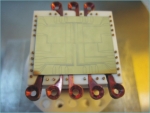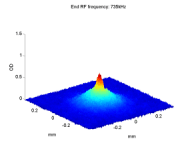Introduction
Atoms are the building blocks of all matter. They have a positively charged nucleus and electron clouds define their outer boundaries. In nature, they remain electrically neutral. The number of electrons governs their chemical properties. All these have long been studied and exploited by mankind. Yet we are just now learning a whole new way of communicating with atoms, and 4 related Nobel prizes were given as a result in 1997 and 2001, 2005 and 2012. The atom chip is a chapter in this new dictionary - translating from human language to atom language. This journey may lead to new insights into the foundations of quantum theory, and numerous technological applications.
Many of today's electronic devices are unthinkable without miniaturization. By similarly shrinking elements used in atom optics, such as atom traps, guides, mirrors, beam splitters and interferometers, and by fabricating them using modern solid-state fabrication (lithography) techniques stemming from the well established and rich know-how in electronics and optics, we hope to achieve similar control over atoms as we have over electrons and photons. The preparation, manipulation and measurement sensitivity must reach the level in which delicate quantum effects are dominant.
The basic idea of the atom chip is to have a solid state device produce light, magnetic and electric fields, which would trap, manipulate and measure atoms hovering a few microns outside the device in ultra high vacuum. Hence, we are using much the same technology as the semi conductor chips of today; however, our system is not the electrons running inside the solid device (and hence are subject to lack of isolation), but rather atoms hovering outside it.
What is unique about this new tool box? First, let us note that studying quantum behavior requires isolation of the observed system from its environment because any interaction would quickly destroy the delicate quantum effects. The neutral atom is an excellent choice in this matter: because it has no charge, it interacts with its environment in a relatively weak way.
Second, atom-chips offer an experimental tool box that is robust, scalable (e.g. with arrays of traps) and accurate. Lithographic techniques can now create structures with length scales below 100 nm, which is smaller than the quantum-mechanical (de-Broglie) wavelength of the cooled atoms, ensuring control at the quantum level. The small size of the traps allows atoms to be positioned in individual sites separated by small distances, thus enabling them to interact in a controlled way. The fact that the atoms are well localized (state size of 10nm) also enables to address them for manipulation and detection by extremely local miniaturized light elements such as micro cavities and solid state wave guides, which today may be fabricated in the same fabrication process, thus creating a monolithic device. To enable a complicated web of independent wires and light guides, several layers of structures will be needed on the chip and consequently 3d fabrication will have to be initiated. Finally, a long term goal would be to fabricate on the same chip even the light sources (micro-lasers) and readout electronics, hence realizing a truly integrated self-sufficient device. The hope is that such devices will do for quantum atom optics what integrated circuits did for electronics.
As we are now able to trap and cool the atoms on the atom chip (all the way to nano Kelvin temperatures in a Bose-Einstein Condensate), we are able to control their position and velocity. Furthermore, we also know how to control their internal properties, namely, the state of the electron clouds in the atom, known as hyperfine states. Hence, all relevant parameters can now be controlled and measured. This should bring atom manipulation (matter wave quantum optics) capabilities to a level enabling interesting experiments concerning chaos (using complex field potentials), non-linearity (due to atom-atom interactions), entanglement (atom-atom correlations), atom-light interactions, low dimensional physics and more.
Another issue regarding which the atom-chip may award us with more insight is quantum decoherence. Decoherence is the process responsible for the classical features of our everyday world, despite its underlying quantum nature — it is what happens when a quantum state is destroyed. This elusive border between classical and quantum states has been a source of debate and confusion since the early days of quantum theory. In atom chip experiments, decoherence can be examined in complicated potentials (e.g. double well) and with carefully tailored environments. Furthermore, the very interesting question of surface-induced decoherence can be addressed in detail; indeed it must, as such decoherence may undermine the whole concept of the atom-chip.
What else? Aside from providing researchers with a strong experimental tool with which to probe nature, one might expect in the future to see technological implementations such as miniaturized versions of highly accurate atomic clocks and acceleration sensors, which are already used for precision measurements. Such tiny systems could prove useful for example in navigation systems. Next, the atom-chip could be integrated into quantum communication and encryption systems, which ensure information security, and which are currently being tested in labs. In quantum information, a ‘qubit’ is the quantum equivalent of a classical ‘bit’ of information. So, for example, the atom-chip may enable the conversion of ‘flying qubits’ (photons that can travel distances in optical fibers) into ‘storage qubits’ — atoms that may be kept in a single location for a long time without changing their quantum state. A final example, and the most far reaching, is the quantum computer, for which quantum theory predicts a new type of computing logic, able in some cases, to outrun the present classical computers by many orders of magnitude in processing time. Once further advance is made on issues such as single atom trapping and controlled atom-atom interaction (entanglement) – the basic computational element, the atom chip could turn out to be the obvious choice for building a quantum computer.
See our review paper, in Papers section.

